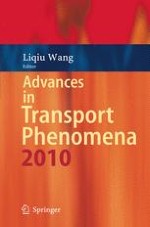2011 | OriginalPaper | Chapter
Nonequilibrium Transport: The Lagging Behavior
Authors : D. Y. Tzou, Jinliang Xu
Published in: Advances in Transport Phenomena 2010
Publisher: Springer Berlin Heidelberg
Activate our intelligent search to find suitable subject content or patents.
Select sections of text to find matching patents with Artificial Intelligence. powered by
Select sections of text to find additional relevant content using AI-assisted search. powered by
Lagging behavior describes the non-instantaneous response between heat flux and temperature gradient in nonequilibrium heat transport. Extending over to mass transport, mass flux is in place of the heat flux while density/concentration gradient is in place of the temperature gradient. The lagging behavior may occur during the ultrafast transient; in times comparable to the intrinsic times characterizing the nonequilibrium transition of thermodynamic states. For heat transport, such intrinsic times include the mean free time of energy carriers and the thermalization time for the energy carriers to come to thermal equilibrium. For mass transport involving different species, on the other hand, the intrinsic times include the finite time required for the effective interdiffusion among the participating substances, the finite time required for the chemical reactions to take place in forming the interfacial substance, or in some cases the finite times required for releasing or absorbing specific species. This chapter is dedicated to the lagging behavior during the ultrafast response in nonequilibrium heat/mass transport. The process is termed “ultrafast” because the time scales involved are comparable to the intrinsic time scales governing the various nonequilibrium processes in heat/mass transport. The essence of thermal lagging will be first illustrated by well known examples in microscale heat transport, with emphasis on the admissibility within the framework of nonequilibrium thermodynamics. Equivalence of the lagging behaviors in heat and mass transport then follows to stretch the lagging response over to the growth of the ultrathin film/interfacial compound, bioheat transfer, and multistage interdiffusion for drug delivery in tumor cells. In the full spectrum from the electron/phonon interactions in femto- to picoseconds, the heat exchange between blood and tissues and drug delivery in minutes to hours, to the ultrathin film/interfacial compound growth in days, the sources for lagging are identified and the analytical expressions for the phase lags are derived. A regime map based on the response time is established to characterize the alterations between wave and high-order diffusion as the phase lags of the various orders activate/diminish at certain time scales. The concept of thermal lagging, which is a nonequilibrium behavior in time, is extended to cover the nonlocal response in space in making contacts with ultrafast heat transport through the phonon gas with a finite mass. The correlation length and intrinsic times are linked together in describing the ultrafast thermal transport in small scales.
